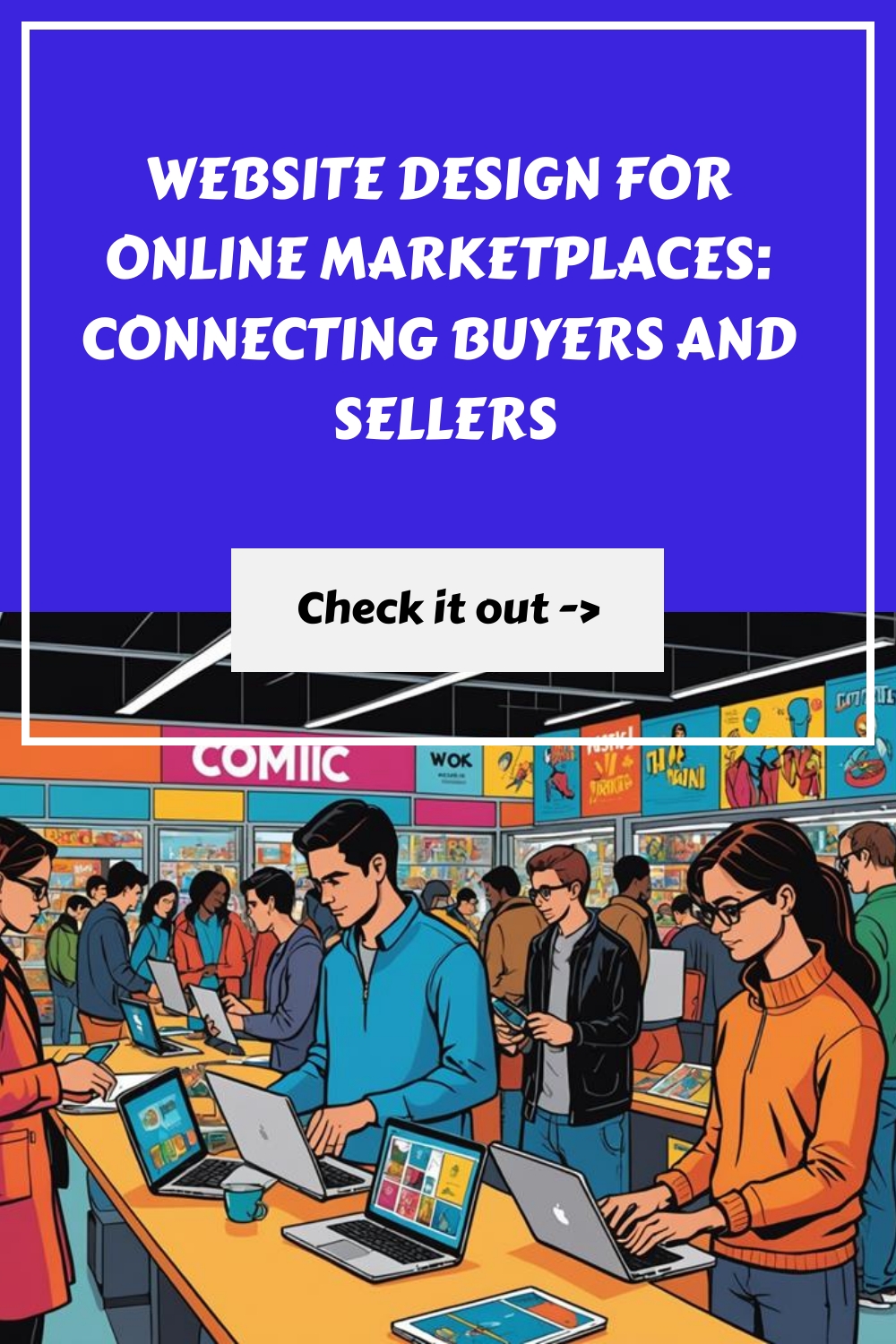
When you design an online marketplace, connecting buyers and sellers is key. You want easy navigation so users can find products quickly without feeling lost. Consider using search functions, since over 70% of people prefer them to browsing. A clean layout and clear calls-to-action can also help boost sales. Plus, secure payment options make shopping feel safer and more convenient. As you build your platform, remember that happy users are likely to return, creating a vibrant marketplace. With so many strategies to explore, there's more to uncover about making your site a thriving hub for trade!
Key Takeaways
- Implement intuitive navigation to help users easily find products and connect buyers with sellers efficiently.
- Optimize the website for mobile devices, as over 52% of web traffic comes from mobile users.
- Ensure effective search functionality to meet user needs quickly, avoiding site abandonment within 5 seconds.
- Create clear categories and filters to enhance user navigation and improve engagement on the platform.
- Incorporate seller profiles with detailed information to build trust and boost conversion rates among buyers.
Understanding Marketplace Design

When you immerse yourself in marketplace design, it's fundamental to prioritize intuitive navigation that makes it easy for users to connect with products and services. A well-structured design elevates user experience, allowing everyone, especially mobile users, to easily explore your offerings. With 50% of eCommerce traffic coming from devices like phones and tablets, ensuring your site responds well across different screens is vital. Implementing comprehensive web design can greatly enhance your online presence and facilitate better user interaction.
You also want robust search functionality and filtering options. These features let users find what they need quickly, making shopping enjoyable. Clear calls-to-action (CTAs) guide users through their buying journey, boosting conversion rates, which can average around 1.53% across eCommerce sites.
Including user-generated content, like online reviews and ratings, builds trust among your buyers. Did you know that 79% of consumers trust online reviews as much as personal recommendations? This trust can make or break a sale.
User Experience and Navigation
When you think about user experience in online marketplaces, intuitive navigation is key. If your layout is confusing, users might leave before they even find what they're looking for. A responsive design can help you create a seamless experience across devices, making it easier for buyers to browse and shop anytime, anywhere.
Intuitive Navigation Design
Intuitive navigation design is essential for enhancing user experience in online marketplaces. When users can easily find what they need, they're more likely to stay engaged. A visually appealing navigation structure helps make exploring the site enjoyable. Here are some key features of intuitive navigation design:
- Clear categorization helps users find products quickly.
- A robust search function allows for instant access to specific items.
- Breadcrumb navigation shows users where they are, making it easier to backtrack.
Studies show that 70% of users prefer using a search function rather than browsing through categories. This highlights the importance of having a solid search feature. Plus, since over 50% of web traffic comes from mobile devices, mobile optimization is vital for offering a smooth experience, no matter the screen size. Regular usability testing helps you refine your navigation by gathering user feedback and understanding customer needs better. This ongoing process can really boost user satisfaction and keep bounce rates low. Remember, an intuitive navigation design not only enhances the overall user experience but also helps create a welcoming online marketplace where buyers and sellers can connect easily.
Responsive Interface Essentials
Creating a responsive interface is vital for online marketplaces to secure users enjoy a seamless experience, regardless of the device they're using. With over 52% of web traffic coming from mobile devices, it's essential to adapt your design for all screens. A well-structured interface guarantees that navigation is easy and intuitive, which makes shopping more enjoyable.
Effective navigation should include clear categories, filters, and a robust search function. Did you know that 70% of consumers prefer searching for products rather than browsing? By providing a user-friendly design with organized layouts and prominent calls-to-action, you can reduce bounce rates by up to 50%! This encourages users to explore more products, boosting engagement and sales conversions.
Implementing responsive design principles helps create consistent visual hierarchies, making it easier for users to find what they need. Data shows that over 90% of users return to websites that offer a well-structured interface. This highlights the importance of ongoing improvements to user experience in your online marketplace. By focusing on these essentials, you'll not only enhance usability but also create a delightful shopping experience that keeps customers coming back for more!
Key Features for Marketplaces

In the competitive landscape of online marketplaces, incorporating key features is essential for attracting and retaining customers. You want to create a platform that connects buyers and sellers effectively. Here are some must-have features:
- Effective search functionality: Studies show that 30% of users abandon a site if they can't find what they need within 5 seconds.
- User profiles enhance trust: Detailed seller profiles can boost sales conversion rates by 15%.
- Streamlined checkout process: A clear and secure checkout can reduce cart abandonment rates by up to 70%.
Additionally, integrated online payment systems are vital. Customers prefer having various payment options available; 61% are more likely to complete a purchase if their preferred choice is there. A well-implemented review system builds credibility, as 91% of consumers read online reviews before buying. By focusing on these key features for marketplaces, you can create a user-friendly experience that encourages purchases and fosters trust. Your marketplace can stand out as a safe and enjoyable place to shop, turning browsing into buying and ensuring customer satisfaction.
Payment Processing Considerations
When setting up payment processing for your online marketplace, you'll want to think about a few important factors. Offering a variety of payment methods not only makes it easier for customers to buy, but it can also boost your sales markedly. Plus, keeping security in mind and managing transaction fees will help you create a trustworthy and profitable shopping experience for everyone involved.
Payment Method Variety
Offering a diverse range of payment methods is essential for online marketplaces aiming to enhance user satisfaction and reduce cart abandonment. When you provide multiple payment options, like credit/debit cards, digital wallets such as PayPal or Apple Pay, and bank transfers, you make it easier for everyone to shop. This variety can reduce cart abandonment rates by up to 30%!
Here are a few key points to take into account:
- Facilitates cross-border transactions: Offering multiple currencies attracts international buyers.
- Enhances financial data security: Partnering with trusted payment providers guarantees your customers' information remains safe.
- Quick checkout process: An efficient payment processing system can speed up transactions, making customers happier.
Security Compliance Requirements
Ensuring security compliance is crucial for online marketplaces that handle payment processing. You need to follow the Payment Card Industry Data Security Standard (PCI DSS), which lays out strict security requirements to safeguard cardholder information. One effective strategy is implementing tokenization. This method replaces sensitive data with unique tokens, greatly reducing fraud risk because it minimizes the storage of actual card information.
Regular security assessments and vulnerability scans are also key. These practices help you identify and tackle potential risks in your payment processing systems. Plus, using multi-factor authentication (MFA) guarantees that only authorized users can access sensitive payment features, boosting your security measures.
Don't forget the importance of a clear refund process and effective dispute resolution. These elements are crucial for maintaining customer trust during transactions, and they help you comply with consumer protection regulations. By focusing on these security compliance requirements, you not only protect your marketplace but also create a safer experience for buyers and sellers alike. Embracing these practices can lead to increased customer confidence and long-term success for your online marketplace!
Transaction Fees Management
Transaction fees play an essential role in the revenue model of online marketplaces, often ranging from 3% to 15% per sale. These fees, combined with payment processing fees, are imperative for maintaining a healthy platform. Understanding how to manage these costs can greatly benefit you and your sellers.
- Consider a tiered commission structure to reward top-performing sellers.
- Regularly review payment processing options to uncover cost savings.
- Offer multiple payment options to enhance user experience.
By implementing a tiered commission structure, you can motivate sellers to increase their sales volumes, which can lead to more revenue for everyone. Regularly checking payment processing fees helps you find the best deals and save money. Plus, providing various payment options—like credit cards, digital wallets, and bank transfers—reduces the chances of abandoned carts. When buyers have choices, they're more likely to complete their purchases.
Ultimately, managing transaction fees creates a win-win scenario for sellers and buyers. It guarantees everyone feels valued and encourages a thriving online marketplace. Keep these strategies in mind, and you'll pave the way for growth and success in your marketplace!
Marketing Strategies for Growth

Growth in online marketplaces hinges on effective marketing strategies that capture attention and drive engagement. By using social media, you can reach a wider audience and create excitement around your products. Imagine posting eye-catching images and fun videos that get people talking!
Implementing SEO techniques tailored to your marketplace can boost your organic search rankings. Studies show that 70% of online users prefer organic results over paid ads, so optimize your content wisely. Email marketing is another powerful tool. With personalized content and special offers, you could see a return of $42 for every $1 spent! That's impressive!
Don't forget about influencer partnerships. When you collaborate with influencers in your niche, you gain authentic promotion and build trust. Nearly half of consumers rely on influencer recommendations when deciding what to buy. Regularly analyzing user engagement metrics, like click-through and conversion rates, helps you refine your marketing strategies. This way, you can continually improve customer acquisition efforts and attract targeted traffic to your site.
Seller Onboarding and Support
A successful marketplace not only attracts buyers but also empowers sellers to thrive. To create an inviting environment for sellers, an effective onboarding process is essential. When you streamline seller onboarding with guided tutorials and step-by-step registration, you can boost seller retention rates by up to 50%.
Here are some key elements to focus on:
- Verification mechanisms: Identity checks and product quality assessments help maintain high standards, building trust with buyers.
- Support resources: FAQs and dedicated onboarding specialists improve seller satisfaction, reducing time-to-market by 30%.
- Feedback loops: Regularly asking for input from sellers during onboarding can identify pain points, leading to a more engaged seller community.
Measuring Success and Adaptation

While measuring success in online marketplaces might seem intimidating, focusing on key performance indicators (KPIs) can simplify the process. You'll want to keep an eye on conversion rates, as they show how many visitors are turning into buyers. Gathering user feedback is also essential; it helps you adapt your offerings to meet customer preferences, making everyone happier.
Tracking user retention rates and seller performance can reveal areas needing improvement. For instance, if a seller isn't performing well, you can offer them support. A/B testing your website's design allows you to see what changes lead to better user experience and increased sales. This data-driven approach really pays off!
Don't forget to analyze market trends too. By keeping up with what's happening in your industry, you can pivot your business model when necessary. It's all about staying relevant and competitive in today's fast-paced digital world. Remember, measuring success isn't just about numbers; it's about learning and growing. By focusing on these KPIs, you can enhance operational efficiency and create a thriving marketplace that connects buyers and sellers effectively.
Frequently Asked Questions
How to Design a Marketplace Website?
To design a marketplace website, focus on user experience with a responsive design. Optimize your user interface, integrate secure payment features, showcase customer reviews, and implement SEO strategies for effective product listings and branding strategy. Guarantee scalability too.
What Is a Website That Allows Buyers and Sellers to Make Transactions?
You'll find e-commerce platforms that enhance user experience, ensuring transaction security through robust payment gateways. These sites prioritize mobile optimization, streamline seller onboarding, showcase product listings, and provide customer support to boost brand visibility amid market trends.
What Makes Marketplaces so Attractive to Both Buyers and Sellers?
Marketplaces attract you with diverse product variety and competitive pricing, enhancing user experience. Trust factors build customer loyalty, while effective marketing strategies boost brand recognition. Plus, convenient payment options and shipping solutions align with current market trends.
Are Websites That Bring Buyers and Sellers Together in the B2B Electronic Commerce Marketplace?
You might think B2B platforms lack user experience, but they excel in features like seller onboarding, payment processing, and customer verification. Effective inventory management and data analytics enhance trust-building, making these marketplaces essential for businesses.
Final Thoughts
Creating an online marketplace is a journey filled with excitement and challenges. You'll connect buyers and sellers, build a vibrant community, and foster trust. As you navigate the design, think about user experience, essential features, and effective marketing. Remember, every decision shapes your marketplace's success. By supporting sellers and measuring growth, you'll adapt and thrive. Embrace the challenges, celebrate the wins, and keep pushing forward—because your marketplace can truly make a difference in people's lives.
- Writing Content That Converts Visitors Into Customers - 04/11/2025
- How to Plan a Content Calendar That Works - 29/10/2025
- SEO Content vs. Social Media Content: What’s the Difference? - 23/10/2025




